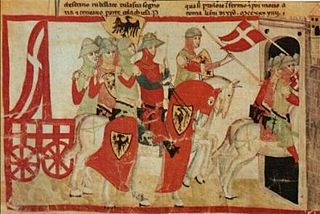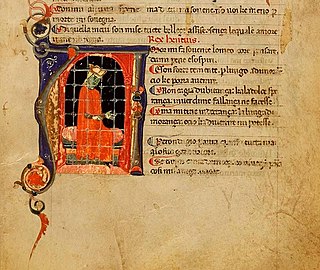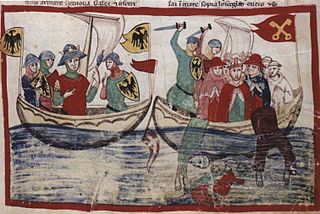Background
The free commune of Parma had been a longtime supporter of the Ghibelline (pro-imperial) party. However, it was also considered an important stronghold to take by the Guelphs (pro-papal), due to its flourishing economy and its position across the Via Francigena. [8] [9]
On 25 June 1243 Innocent IV, who had several friends in the city and had held several positions in the local diocese, was elected as pope. He thus started a plan to bring Parma to the Guelph side, by replacing the current bishop with Alberto Sanvitale, who was more loyal to him, and order the local Franciscans to convince the population to change side. [10] The already strained relationship between Emperor Frederick II and the pope worsened: the situation was further aggravated by the coup by which the city fell in the hands of a Guelph group, including Ugo Sanvitale (the brother of the new bishop of Parma) and Bernardo di Rolando Rossi (the pope's brother-in-law and a former collaborator of Frederick). [8]
The emperor knew of the rebellion when he was at Pavia. He immediately mustered an army, marched against Parma from Emilia, ousted Rolando Rossi, and installed Tebaldo Franceschi as the new city's captain. Innocent IV, however, continued his hate campaign against Frederick both in Lombardy and the Kingdom of Sicily with letters to the local nobility and clergymen. Several noblemen, including the Sanseverino and three Fasanella, set a plot against the emperor in 1244: however, they were betrayed by a participant, and many were arrested and executed. Some conspirators sought the protection of the pope, who, in the meantime, had moved to Lyon, which was more distant from the imperial armies. [10] Here he summoned the Council of Lyon in 1245, where it was decided to confirm the excommunication of the emperor, proclaimed in 1227 by Gregory IX.
Battle
Now that the papal participation in the plot against him had become clear, Frederick wrote to the noblemen to inform them of the pope's vile behavior, and marched with an army to Lyon in 1247. Once he had arrived in Turin, however, he received news that Parma had rebelled again. According to Salimbene di Adam, a group of Guelph Parmigian refugees who had taken shelter in Piacenza led by Ugo di Sanvitale (the brother of the new bishop of Parma) and Bernardo di Rolando Rossi (the pope's brother-in-law and a former collaborator of Frederick). They defeated the imperial garrison under the imperial podestà Enrico Testa near Borghetto di Taro and occupied the city with no resistance, since the garrison of Enzio of Sardinia, Frederick's son, was besieging Quinzano. [9] Frederick immediately diverted his troops to Emilia, and at the same time he called for reinforcements from friendly lords and communes. The imperial army was also joined by Enzio, who raised the siege of Quinzano, and by a Cremonese contingent led by Ezzelino III da Romano, as well as by soldiers from Padua, Verona, and Vicenza.
The pope did his best to send help to Parma from cities faithful to him, such as Milan, Piacenza, Mantua, and Ferrara. Gregorio di Montelongo was able to reach the city, organizing its defense with Bernardo Rossi and Gilberto da Gente.
Perhaps due to a shortage of siege weapons, Frederick decided to take the city by starvation. The Guelphs were however determined to resist thanks to the papal help, and the siege dragged on for eight months. Frederick ordered the construction of an entrenched camp near Grola, calling it Victoria (Latin for "victory"), [9] including houses, palaces, and a church, declaring that it would become the seat of his kingdom after the fall of Parma. However, several noblemen abandoned him. Further, on 12 February 1248 Gregorio di Montelongo launched a sortie: after the sufferings they had faced during the siege, the people in arms followed the image of the Holy Virgin and attacked, Frederick was hunting in the Taro valley, and Vittoria was destroyed. He took refuge at Borgo San Donnino, and then moved to Cremona. [8]
Aftermath
The defeat at Parma was a decisive defeat for Frederick, who had to abandon forever any dream to conquer northern Italy. The Second Lombard League recovered some territories, the whole Emilia and Romagna embraced the Guelph cause, while the Marquisate of Montferrat and the Republic of Genoa remained hostile to him. Ezzelino III, despite remaining in the Ghibelline side, ousted the imperial governor from Monselice.
According to anti-imperial Franciscan chronicler Salimbene di Adam, "Parma fuit causa totius ruine" ("Parma was the cause of the whole ruin"). [9]
Since then, the town's motto has been "Hostis turbetur quia Parmam Virgo tuetur" ("May the enemy be scattered, because the Holy Virgin protects Parma").

The Guelphs and Ghibellines were factions supporting respectively the Pope and the Holy Roman Emperor in the Italian city-states of Central Italy and Northern Italy during medieval time.

The Lombard League was a medieval alliance formed in 1167, supported by the popes, to counter the attempts by the Hohenstaufen Holy Roman emperors to assert influence over the Kingdom of Italy as a part of the Holy Roman Empire. At its apex, it included most of the cities of Northern Italy, but its membership changed with time. With the death of the third and last Hohenstaufen emperor, Frederick II, in 1250, it became obsolete and was disbanded.

The Battle of Cortenuova was fought on 27 November 1237 in the course of the Guelphs and Ghibellines Wars: in it, Holy Roman Emperor Frederick II defeated the Second Lombard League.

Ezzelino III da Romano was an Italian feudal lord, a member of the Ezzelini family, in the March of Treviso. He was a close ally of the emperor Frederick II, and ruled Verona, Vicenza and Padua for almost two decades. He became infamous as a cruel tyrant, and was, in fact, the most "notorious" of the "early tyrants".

Salimbene di Adam, O.F.M., was an Italian Franciscan friar, theologian, and chronicler. Salimbene was one of the most celebrated Franciscan chroniclers of the High Middle Ages. His Cronica is a fundamental source for Italian history of the 13th century.

Enzo was an illegitimate son of the Hohenstaufen emperor Frederick II, who appointed him 'King of Sardinia' in 1238. He played a major role in the wars between Guelphs and Ghibellines in the Imperial kingdom of Italy, and was captured by his enemies in 1249. He remained imprisoned in Bologna until his death.
The siege of Viterbo was fought in 1243 between the Holy Roman Emperor Frederick II and the rebellious city of Viterbo, 50 km north of Rome.

The Battle of Fossalta was a battle of the War of the Guelphs and Ghibellines in Northern Italy. It took place in Fossalta, a small location on the Panaro River, and is especially remembered for the capture of Enzio of Sardinia, son of Emperor Frederick II of Hohenstaufen.

The naval Battle of Giglio was a military clash between a fleet of the Holy Roman Emperor Frederick II and a fleet of the Republic of Genoa in the Tyrrhenian Sea. It took place on Friday, May 3, 1241 between the islands of Montecristo and Giglio in the Tuscan Archipelago and ended with the victory of the Imperial fleet.
Emilia is a historical region of northern Italy, which approximately corresponds to the western and the north-eastern portions of the modern region of Emilia-Romagna, with the area of Romagna forming the remainder of the modern region.
Alberico da Romano, called Alberico II, was an Italian condottiero, troubadour, and an alternatingly Guelph and Ghibelline statesman. He was also a patron of Occitan literature.
The War of the Bucket or the War of the Oaken Bucket was fought in 1325 between the rival city-states of Bologna and Modena. It took place in the region of Emilia-Romagna, in northern Italy. The war was an episode in the over 300-year-long struggle between Guelphs and Ghibellines. Modena won the Battle of Zappolino, the only battle of the war.
Gregorio di Montelongo was the Bishop of Tripoli from 1249 until 1251 and the Patriarch of Aquileia from 1251 until his death.

Gian Galeazzo Sanvitale, also known as Galeazzo I Sanvitale was an Italian condottiero, a member of the noble Sanvitale family.
Ottaviano or Attaviano degli Ubaldini was an Italian cardinal, often known in his own time as simply Il Cardinale.

Frederick of Antioch (c. 1223 – 1255/6) was an Italian nobleman who served as the imperial vicar of Tuscany from 1246 to 1250. He was an illegitimate son of Frederick II, Holy Roman Emperor, by an unidentified southern Italian noblewoman. He took part in the wars of the Guelphs and Ghibellines in northern Italy, and in the war over the Kingdom of Sicily following his father's death (1250).
Filippo da Pistoia, also called Filippo Fontana or anglicized Philip, was an Italian prelate, military leader and diplomat. He was the bishop-elect of Ferrara from 1239 until 1252, bishop-elect of Florence from 1250 until 1251 and archbishop of Ravenna from 1250 until his death. He was the apostolic legate in Germany between July 1246 and March 1247, in Lombardy and the Trevigiana between December 1255 and August 1258 and throughout northern Italy between 1267 and February 1270. He served as podestà (mayor) of Ravenna in 1254.
Rolando de' Rossi was an Italian nobleman and statesman. He was the dominant force in the politics of the commune of Parma from 1322 until 1335, effectively as signore between 1328 and 1331. Under him and his brother, between 1331 and 1333, the city accepted the lordship of the King of Bohemia. Ultimately, the failure of his family's political project brought an end Parmesan autonomy. In his later years he was a condottiero for Venice and Florence.
Stefano Badoer was a Venetian nobleman.










